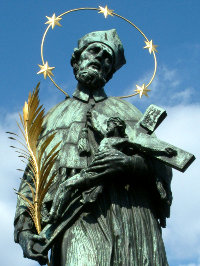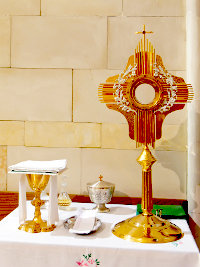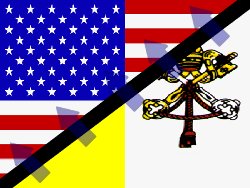
No, we don’t worship Saints.
For the benefit of those who are interested in learning more about Catholicism, I plan on writing occasional posts on common myths. Besides, writing about them is fun!
I really can not tell if these myths come out of ignorance, misinformation or malice. Often there is a very tiny grain of truth that is distorted and twisted beyond recognition to give credence. For the benefit of our non-Catholic Christian brothers and sisters – and everyone else for that matter – I will set the record straight in posts tagged by the keyword “myths” (see TOPICS in the right-hand column).
The grains of truth to today’s myth are (1) Catholics have many statues of Saint inside and outside of our churches and (2) Catholics sometimes pray to Saints.
Saint statues are remembrances of someone who, while imperfect, led inspirational lives worthy of emulating. They had a yearning for holiness, humility, perseverance, love of God and their fellow man. We venerate (reverently remember) Saints. The Catholic church calls on all of us to be saints. Canonized Saints (capital “s”) are those who achieved sainthood in their lives and are formally recognized by the Church. (An interesting point: the Church can not make someone a Saint, rather it only recognizes that they are a Saint.) Many, most or all of our Catholic Saints are also recognized by various Protestant faiths. Some cities (e.g. St. Louis) are named after our Saints.
What is the purpose of a picture? We have them at home, in our wallets and on our desks. They are of someone, living or not, who we wish to remember. Larger, more life-like pictures are all the better. The same applies to Saints… regular pictures are good and 3-dimensional pictures (statues) are better yet. The very latest HDTV technology brings us 3-dimensional images for the same reason – more realistic and immersive.
Statues of Saints are for their remembrance and inspiration. Not so weird.
We sometimes pray to Saints but we never worship them. We do not worship anyone but Jesus Christ our Lord. When we pray to Saints we ask them, from their position in heaven, to pray with us. That is intercessory prayer.
I bet I know what you are thinking. You don’t need any Saint to pray for you because you have a personal relationship with Jesus. Why “go through” anyone else when you can go direct?
Do you ever ask someone to pray for you? Do you ever pray for someone else? Do you believe in the power of prayer? This is no different! It is really that simple.
Praying to Saints is simply asking them to pray for us and others. Not so weird.





















